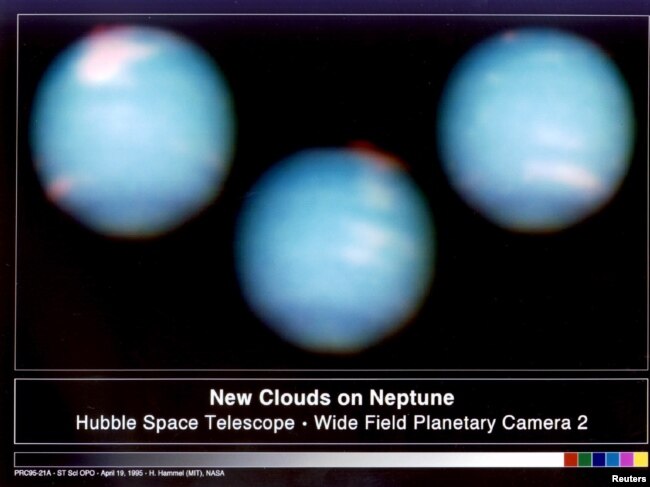昨夜4月17日はきれいな満月でした!! 調べたら、”ピンクムーン”と呼ばれているそうです。
日々の喧騒を離れ、
宇宙のニュースは、心を空へと誘い、解き放ってくれます!!
さぁ、今日もVOAで英語を学びましょう!!
海王星を観測する科学者たちが、惑星が寒冷化していることを発表(和訳)
Scientists Observing Neptune Say the Planet Is Getting Colder
April 18,2022
海王星の新しい観測結果は、この惑星が寒冷化していることを示唆していると研究者は述べています。
天文学者の国際チームは、ハワイとチリにある地上の望遠鏡を使って、海王星の大気温度を推定しました。研究チームは、2003年から2020年にかけて望遠鏡が捉えた約100枚の赤外線画像を調査しました。その結果、海王星は過去17年間に驚くほど大気温度が低下していることがわかったのです。
”氷の巨人”と呼ばれる海王星は、太陽系で最も外側にある惑星です。大きさは地球の約4倍。海王星は太陽から地球の30倍以上の距離を公転しています。つまり、太陽の周りを1周するのに約165地球年かかります。
海王星は、最も探査されていない惑星の一つです。アメリカの宇宙機関NASAのボイジャー2号は、1989年に海王星の近くを通過した唯一の宇宙船です。
今回の海王星の大気温度の調査は、これまでに収集されたものの中で最も詳細なものです。研究チームはこのほど、その成果をPlanetary Science Journalという出版物に報告しました。
研究チームは、海王星の成層圏、惑星の気象層のすぐ上の大気上部に焦点を当てました。海王星の成層圏の温度は、17年の間にマイナス117度まで下がり、8度低下しました。それに比べて、海王星の対流圏– さらに低温の気象層– の温度は大きな変化を示めしませんでした。対流圏の温度は、マイナス223℃まで下がりました。
「この変化は予想外でした。」と、成層圏の測定値についてマイケル・ローマン氏は語ります。彼は英国のレスター大学の博士研究員であり、この研究の主執筆者です。「海王星は、私たちの多くがまだほとんど何も知らないので、非常に興味をそそられると思います」とローマン氏は付け加えます。
彼は、海王星の観測によって、この惑星の状況は最初に考えられていたよりも複雑であると研究者が考えるようになったことを指摘しています。この発見は、"自然が科学者に何度も教えてくれる一般的な教訓のようだ "と、ローマン氏は話しています。
欧州南天天文台(ESO)は声明で、天文学者は宇宙物体からの赤外線を測定するために装備されたカメラを用いて海王星の温度を収集したと述べています。チームの観測のほとんどは、チリ北部にあるESOの超大型望遠鏡で行われました。
温度は時間と共に不均一に変化しました。南半球の熱帯と呼ばれる地域は冷え、暖かくなり、再び冷え込みました。中間の地域では、気温はほぼ同じで、時間の経過とともに下がり始めました。南極の気温は、ほとんどの期間、わずかな低下しか示さなかったと研究者は報告しています。しかし、その後、この地域は急速に急激に暖かくなったのです。2018年から2020年にかけて、南極の気温は11度上昇しました。
「全体的な気温の低下は、季節ごとに変化する太陽光に対応する大気化学の変化による可能性が最も高いと思われます 」と、ローマン氏は語っています。
海王星は、太陽系外惑星と呼ばれる太陽系外の惑星についての教訓を与えてくれるかもしれないと、研究の共著者であるグレン・オートンはいいます。彼はカリフォルニアにあるNASAのジェット推進研究所の惑星科学者です。
海王星が太陽系外惑星の大部分と密接な関係を持つということは、海王星が ’我々の裏庭の太陽系外惑星 ’であるかもしれないということです。」と、オートン教授は話しています。さらに、海王星は将来研究される太陽系外惑星の”気象学で見られると期待されるもののモデル”になる可能性があると付け加えています。
Scientists Observing Neptune Say the Planet Is Getting Colder
Researchers say new observations of Neptune suggest the planet is getting colder.
An international team of astronomers used ground-based telescopes in Hawaii and Chile to estimate Neptune’s atmospheric temperatures. The team examined nearly 100 infrared images captured by the telescopes from 2003 to 2020. The data showed that Neptune experienced a surprising drop in atmospheric temperatures over the past 17 years.
Considered an “ice giant,” Neptune is the outermost planet in our solar system. It is about four times wider than Earth. Neptune orbits more than 30 times as far away from the sun as Earth does. This means it needs about 165 Earth years to complete a single orbit around the sun.
Neptune is among the least explored planets. The American space agency NASA’s Voyager 2 is the only spacecraft to have passed close to Neptune, which it did in 1989.
The latest examinations of Neptune’s atmospheric temperatures are the most detailed ever collected. The team recently reported its findings in the publication Planetary Science Journal.
The researchers centered on Neptune's stratosphere, an upper part of the atmosphere just above the planet’s weather layer. Neptune’s stratosphere temperature fell to minus 117 Celsius, a drop of eight degrees, during the 17-year period. By comparison, temperatures in Neptune's troposphere – the even-colder weather layer – showed no major changes. The troposphere reached temperatures as low as minus 223 Celsius.
“This change was unexpected,” said Michael Roman of the stratospheric readings. He is a postdoctoral researcher at the University of Leicester in Britain and the lead writer of the study. "I think Neptune is very intriguing to many of us because we still know so little about it," Roman added.
He noted that the Neptune observations led researchers to believe that conditions on the planet were more complex than first thought. Roman said the finding “seems to be a general lesson that nature teaches scientists again and again."
The astronomers collected Neptune temperatures using cameras equipped to measure infrared light from space objects, the European Southern Observatory (ESO) said in a statement. Most of the team’s observations were made with the ESO’s Very Large Telescope, which is based in northern Chile.
The temperature changed over time and unevenly. The area of the planet known as the southern tropics cooled, then warmed, then cooled again. In the middle areas, temperatures remained similar before starting to fall over time. Temperatures at the south pole showed only minor drops during most of the period, the researchers reported. But then, the area warmed quickly and sharply. From 2018 to 2020, the temperature at the south pole rose by 11 degrees.
"I suspect the overall temperature drop may most likely be due to changes in the atmospheric chemistry, which responds to changing seasonal sunlight,” Roman said.
Neptune may offer lessons about planets beyond our solar system, called exoplanets, said study co-author Glenn Orton. He is a planetary scientist at NASA’s Jet Propulsion Laboratory in California.
"The close relationship that Neptune may share with a large segment of the population of exoplanets means that it may be 'an exoplanet in our backyard,'” Orton said. He added that Neptune could become “a model for the things we might expect to see in the meteorology” of exoplanets studied in the future.
Words in This Story
giant – n. extremely large
layer – n. the amount of a substance covering a surface
intriguing – adj. very interesting
tropics – n. the hottest part of the world
meteorology – n. the science of planetary atmosphere and weather
segment – n. one of the parts something can be divided into

